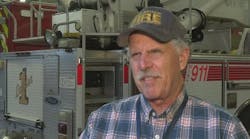Obesity is becoming an American epidemic. An estimated 97 million Americans are overweight or obese. That equals roughly half of the American adult population.
Obese individuals are at a higher risk of many medical conditions, including Type 2 diabetes, stroke, gallbladder disease, arthritis, respiratory problems and some cancers. Obesity is also associated with increased rates of high blood pressure, high cholesterol and cardiovascular disease. In fact, obesity is now regarded as an independent risk factor for cardiovascular disease. Obesity also can impact overall fitness and the ability to perform work. When obesity affects firefighters, it can compromise the safety of fellow firefighters and the public.
Cardiovascular disease continues to be the number-one cause of firefighter line-of-duty deaths (LODD) each year. In addition to being associated with high blood pressure and high cholesterol, obesity significantly impairs respiratory and cardiovascular fitness, increasing the workload on these systems during stress. For firefighters, this increased stress occurs during fire suppression operations where high levels of exertion are required. Obese firefighters are also more likely to have a decreased tolerance to heat exposure and may be at a higher risk of the detrimental effects of heat exposure. Simply put, obese firefighters are at a higher risk of cardiac LODD than non-obese firefighters.
Obese individuals have been shown to have significant impairments on physical activity. The extra body mass stresses the cardiovascular system and impairs an individual's ability to perform physical activity. As the body mass increases, the heart enlarges to supply the extra body mass with blood. The heart also has to pump harder to overcome the resistance in the vascular beds of the fat tissue. These factors increase the workload of the heart even during rest, and physical exertion further increases the demand on the already taxed cardiovascular system.
Obesity is defined as a body mass index (BMI) greater than 30. The BMI is calculated by using a ratio of an individual's height versus weight. It must be noted that a BMI is not a perfect measure and that muscular individuals may have a falsely high BMI due to the extra muscle mass. Therefore, BMI measurements must take into consideration a firefighter's body type. Overweight is defined as BMI 25 to 29.9 and a normal BMI is considered 18.5 to 24.9. Current recommendations outlined in National Fire Protection Association (NFPA) 1582, Standard on Comprehensive Occupational Medical Program for Fire Departments, is to measure and record firefighter BMIs during physical exams. However, the NFPA standards make no further recommendations on what to do with this information.
Firefighting is a physically demanding activity that requires high levels of cardiovascular functioning to typically perform tasks at structure fires. Studies have documented that ladder work, carrying tools and equipment, and other physical support tasks as well as interior firefighting requires high levels of cardiovascular functioning. Extreme obesity (BMI greater than 40) has been documented to severely impair an individual's cardiovascular capacity and lower exercise tolerance. These factors place obese firefighters at risk due to the high stress on the cardiovascular system. This also places other firefighters and the public at risk, since obese firefighters may not be able to perform required tasks or may become incapacitated requiring a firefighter-rescue situation. Additionally, it is hard enough to try to extricate an average-sized firefighter from a firefighter-rescue situation. Rescuing an obese firefighter with the extra weight of self-contained breathing apparatus (SCBA) and personal protective equipment (PPE) would be technically difficult and extremely labor intensive.
Multiple studies have demonstrated that significant levels of firefighters are either overweight or obese. Additionally several studies have demonstrated that the proportion of firefighters who are overweight or obese increases as they age. This has several implications; the first is that annual exams with BMI analysis would offer an opportunity to screen for this condition. The second is that healthy body weights could be maintained through preventative measures.
Losing weight and maintaining a healthy body weight is a function of two components: diet and exercise. Following a heart-healthy diet consists of a diet low in fat and sodium and rich in whole grains and fruits and vegetables. This diet typically contains fewer calories than a typical diet high in fat, simple carbohydrates and fried foods. Additionally, a heart-healthy diet contains more fiber than the typical American diet, resulting in feeling fuller earlier in meals and consuming fewer calories.
Exercise is the other component to losing weight. Current recommendations are 30 minutes of aerobic exercise a minimum of four times a week. Firefighters could be counseled during physical exams if they were found to be overweight or obese and could be given weight-loss strategies from qualified medical personnel. Additionally, firefighters could be referred to dietitians for further assistance in their weight-loss measures.
It is also recommended that extreme obesity be adopted by the NFPA as a Category A condition. Category A conditions are medical conditions that could severely impair a firefighter during firefighting operations and are exclusionary criteria for the position of firefighter. It is also recommended that all fire departments adopt extreme obesity as exclusionary criteria to firefighting. Extreme obesity has been shown to severely impair an individual's work capacity and aerobic functioning, which could place these individuals and other emergency responders at risk during an emergency. Career fire departments could make BMIs of less than 30 (all categories of obesity) criteria for employment to motivate their employees to keep their BMIs at acceptable levels. Volunteer fire departments could make a BMI of less than 30 criteria to perform interior structural firefighting, the most demanding task that occurs on the fireground.
Firefighting is a physically demanding activity that requires conditioning to perform optimally. Reducing the number of firefighters who are overweight or obese can improve the overall health of firefighters and reduce their risk of cardiac line-of-duty deaths. The first step includes annual physical exams with BMI monitoring and identifying firefighters who are overweight or obese. Offering guidance and weight-reduction strategies that can help firefighters can be implemented during these exams. These firefighters can then be monitored closely for other cardiac risk factors and their progress during their efforts. Above all, the goal of these recommendations is to give all of us the best chance to return home safely.
DR. RAYMOND BASRI, MD, FACP, is in the private practices of internal medicine and diagnostic cardiology in Middletown, NY. Dr. Basri is a Diplomate of the American Board of Internal Medicine and president of the Mid-Hudson Section. He received the 2008 Laureate Award of the American College of Physicians, of which he is a Fellow. Dr. Basri also is clinical assistant professor of medicine at New York Medical College, attending physician in the Department of Internal Medicine at Orange Regional Medical Center and on the consulting staff in cardiology at The Valley Hospital in Ridgewood, NJ. He is a member of the Excelsior Hook and Ladder Company in Middletown and a deputy fire coordinator for Orange County. Dr. Basri is the senior physician of the Disaster Medical Assistance Team (DMAT NY-4). He is a senior aviation medical examiner for the Federal Aviation Administration (FAA) and chief physician for Health & Safety Specialists in Medicine, which does onsite medical examinations for the fire service and consultant to FirePhysicals.com. ERIC BERGMAN, PA-C, is a physician assistant practicing internal medicine at Hartford Hospital in Hartford, CT. He earned a bachelor of science degree in allied health from the University of Connecticut and a master's degree from Albany Medical College. He is a member of the Killingworth, CT, Volunteer Fire Company; a past company officer and life member of the Avon, CT, Volunteer Fire Department; and a past member of the Shaker Road-Loudonville Fire Department in Colonie, NY.





